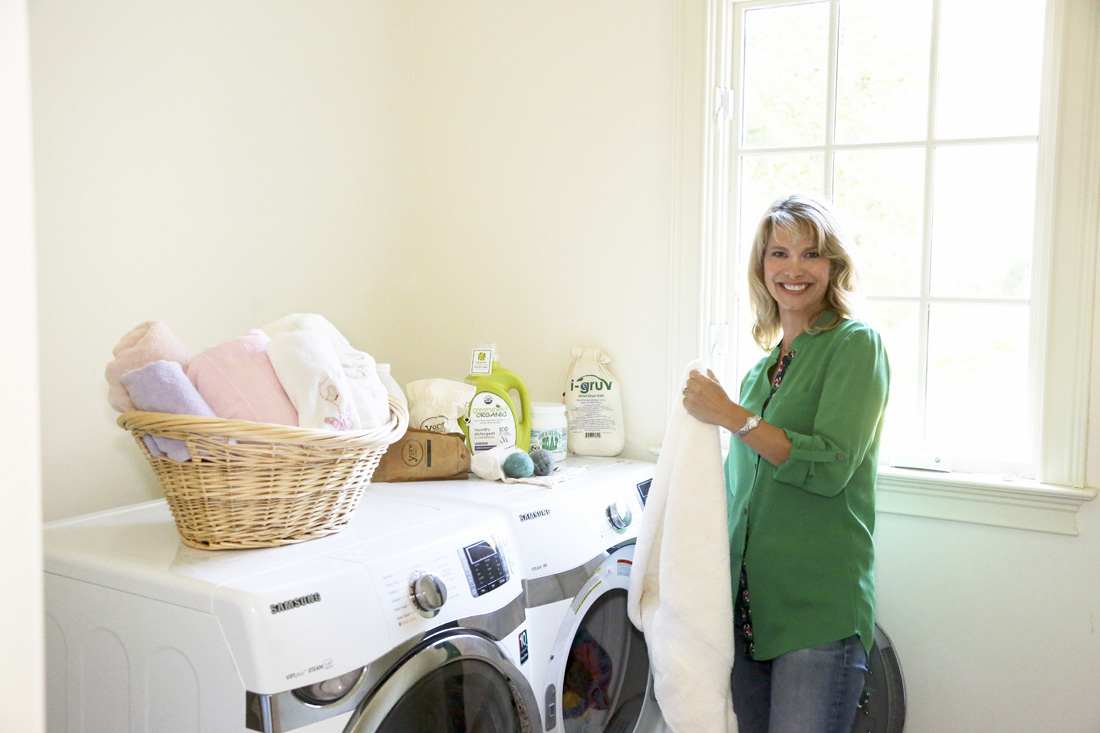Green your cleaning products.
The laundry room often turns into the central hub for storing cleaning products in a home. One of the easiest eco-friendly swaps you can make is changing your cleaning products and laundry detergents. “You don’t need to throw everything away immediately—let’s face it, you’ve been using this stuff for years, so what’s another month going to do? As you run out of something, that’s when you should switch to a green alternative,” Hankey says. Don’t be fooled by product labeling and marketing verbiage, however. Leslie Reichert, founder of Green Cleaning Coach and a consultant with Maid Brigade, a green house-cleaning service in Buckhead, explains, “When trying to green up your cleaning products, it takes a little bit of education because the cleaning industry is not required to tell you what ingredients are in the products. The problem is, you look at a label and are swept in by wording—‘natural,’ ‘green,’ safe’— but when you actually look at what’s in it (if they have the ingredients listed), it can very dangerous.” Before buying a new product, both Hankey and Reichert recommend checking out the Environmental Working Group’s website, Ewg.org/cleaners, that features a comprehensive database rating thousands of cleaners on the market with an A (lowest concern with few or no known hazards to health or the environment and good ingredient disclosure) to F (highest concern with potentially significant hazards to health or the environment or poor ingredient disclosure). One product line in particular that Hankey likes is GreenShield Organic (available at Costco in Brookhaven and Whole Foods Market in Buckhead and Sandy Springs). The laundry detergent, as well as all-purpose cleaners for the home, are made with plant-based ingredients, are animal-friendly and toxin-free, and have no synthetics or GMOs. As for DIY detergents and cleaners, Reichert says you can clean almost everything with six basic items: vinegar, baking soda, salt, lemon juice, oxygen bleach and hydrogen peroxide. “Our grandmothers used these things up until the ’50s. There was a huge change in thought after World War II, when chemical companies making products for the war switched their marketing to consumers and households. Up until then, all those old-fashioned ingredients were used, and everything worked great!” Reichert explains.
Throw out your dryer sheets.
This is one product that you can get rid of ASAP. “Dryer sheets are so toxic and completely unnecessary!” Hankey says. “They contain petrochemicals [chemical products derived from oil or natural gas] that stick to your clothes, synthetic fragrances that cause allergic reactions, phthalates that are known to mimic estrogen in your body and are linked to ovarian cancer and more.” Simply swap them out for reusable wool dryer balls, such as Molly’s Suds Wool Dryer Balls (available at Target locations in Buckhead and Sandy Springs), that you throw into the dryer to fluff clothes and remove static. If the yummy scent of dryer sheets is what makes you love them so, then add a couple drops of an essential oil such as lavender on the wool balls to get an au naturel fragrance fix.
Use cold water.
Did you know at least 50 percent of the energy used when washing is to heat the water? That’s why Jillian Pritchard Cooke, founder of Wellness Within Your Walls, an informational resource group that provides education and guidance on chemicals commonly found in living and working spaces, recommends opting for cold-water washes as much as possible. You’ll not only save a lot of energy, but also a few bucks. Can you really clean dirty clothes in cold water, though? For the most part, yes; but make sure to use a cold-water-compatible laundry detergent, such as GreenShield Organic Laundry Detergent, and note that many powder formulas are made for use with warm water. “I generally save hot water for known bacteria and environmental exposures, such as bed linens, diapers and clothes exposed to pesticides. Many washing machines have the option for a hot wash and a cold rinse. This is better for immediately eliminating germs, and the cold water rinse helps reduce energy use, and your clothes last longer,” Cooke explains.
STORY: Karina Antenucci
PHOTOS: Sara Hanna
Managing Editor and Wellness Columnist at Simply Buckhead. Blogger at Badass + Healthy.














